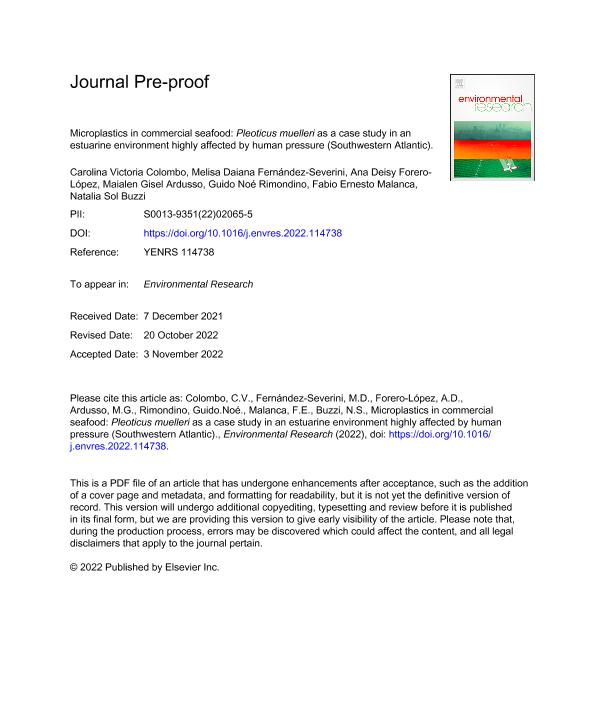Artículo
Microplastics in commercial seafood: Pleoticus muelleri as a case study in an estuarine environment highly affected by human pressure (Southwestern Atlantic).
Colombo, Carolina Victoria; Fernandez Severini, Melisa Daiana ; Forero Lopez, Ana Deisy
; Forero Lopez, Ana Deisy ; Ardusso, Maialen Gisel
; Ardusso, Maialen Gisel ; Rimondino, Guido Noé
; Rimondino, Guido Noé ; Malanca, Fabio Ernesto
; Malanca, Fabio Ernesto ; Buzzi, Natalia Sol
; Buzzi, Natalia Sol
 ; Forero Lopez, Ana Deisy
; Forero Lopez, Ana Deisy ; Ardusso, Maialen Gisel
; Ardusso, Maialen Gisel ; Rimondino, Guido Noé
; Rimondino, Guido Noé ; Malanca, Fabio Ernesto
; Malanca, Fabio Ernesto ; Buzzi, Natalia Sol
; Buzzi, Natalia Sol
Fecha de publicación:
11/2022
Editorial:
Academic Press Inc Elsevier Science
Revista:
Environmental Research
ISSN:
0013-9351
Idioma:
Inglés
Tipo de recurso:
Artículo publicado
Clasificación temática:
Resumen
Plastic pollution in seafood has become a worldwide safety concern due to its possible harm to humans. This is the first study which has investigated the length-weight relationship, growth patterns and condition factor, together with the concentrations of microplastics (MPs) and mesoplastics (MesoPs) in Pleoticus muelleri from the Bahia Blanca Estuary (BBE), Argentina. Forty-nine individuals were collected from three sampling stations in the BBE, and each abdominal muscle with the gastrointestinal tract was analyzed. P. muelleri showed an isometric growth pattern (b = 3.0054) with values of K similar among the individuals collected (ranged between 0.80 and 0.91), considering them in good condition compared to other crustacean species around the world. 96% of shrimp presented transparent or black synthetic fibers as prevalent types, with an abundance average of (3.0 ± 2.90) MPs/g w. w. And (0.053 ± 0.16) MesoPs/g w. w. as well as a dominant size range of 0.5–1.5 mm, in accordance with recent studies in the same area. The linear regression analysis showed that K was independent of the concentration of MPs ingested by P. muelleri, with R2 ranging between 0.024 and 0.194 indicating that MPs contamination does not affect the nutritional condition of shrimp. SEM/EDX detected the presence of elements like C, O, K, and Mg, tissue residues and fractures on the surface of the analyzed fibers. FTIR confirmed different types of polymers in shrimp related to textile fabrics probably from untreated sewage discharges from nearby cities. The results of this research provide useful information for a better understanding of MPs contamination in seafood, suggesting P. muelleri as a suitable species for monitoring MPs in estuarine ecosystems. Likewise, more research is required to know the effects of MPs on food safety in humans.
Palabras clave:
CELLULOSE
,
CONDITION FACTOR
,
EMERGING CONTAMINANTS
,
FOOD WEB
,
MICROPLASTICS
,
SHRIMP
Archivos asociados
Licencia
Identificadores
Colecciones
Articulos(IADO)
Articulos de INST.ARG.DE OCEANOGRAFIA (I)
Articulos de INST.ARG.DE OCEANOGRAFIA (I)
Articulos(INFIQC)
Articulos de INST.DE INVESTIGACIONES EN FISICO- QUIMICA DE CORDOBA
Articulos de INST.DE INVESTIGACIONES EN FISICO- QUIMICA DE CORDOBA
Citación
Colombo, Carolina Victoria; Fernandez Severini, Melisa Daiana; Forero Lopez, Ana Deisy; Ardusso, Maialen Gisel; Rimondino, Guido Noé; et al.; Microplastics in commercial seafood: Pleoticus muelleri as a case study in an estuarine environment highly affected by human pressure (Southwestern Atlantic).; Academic Press Inc Elsevier Science; Environmental Research; 216; 4; 11-2022; 114738-114852
Compartir
Altmétricas



